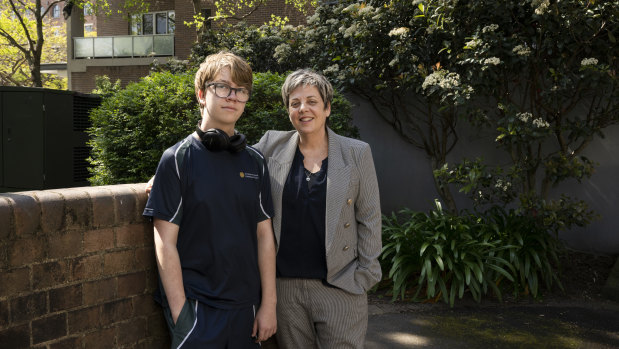This was published 9 months ago
Nothing to sneeze at: Why so many Australians suffer from hay fever
Experts are warning of a challenging hay fever season this year, with a record one-in-four Australians now suffering from the debilitating condition.
The latest Australian Bureau of Statistics data shows that 24 per cent of Australians are afflicted by allergic rhinitis – the scientific name for the widespread condition – up from 15 per cent in 2008.

Hayfever sufferers Kylie Gwynne with her 17-year-old son Sammy.Credit: Louise Kennerley
Doctors and optometrists are already seeing an increasing number of patients presenting with hay fever symptoms, despite the pollen season typically not starting until October.
Symptoms include itchy or red eyes, frequent sneezing, coughing and a runny nose.
Luke Arundel, chief clinical officer at Optometry Australia, said delaying treatment could lead to a condition called keratoconus, which is often caused by excessive eye rubbing and can lead to long-term sight problems.
“Constantly rubbing itchy eyes exerts a large increase in pressure on the cornea, the clear window at the front of the eye which helps us to focus light clearly,” he said. “This repetitive friction gradually weakens this window and can cause it to change shape or distort, leading to blurry vision.”
He said hay fever can also impact concentration and productivity.
“People often find that their sleep suffers, leaving them feeling tired and irritable,” he explained.
“It’s not uncommon for someone to avoid outdoor activities altogether to keep their symptoms in check, which can be frustrating. And for those with asthma, hay fever can make breathing even more difficult, adding another layer of discomfort.”
Artificial tear drops that wash allergens from the eye, antihistamines and steroids can provide relief for hay fever sufferers, he said.
Professor Janet Davies from Queensland University of Technology and the National Allergy Centre of Excellence said climate change had led to unpredictable pollen seasons, fuelling a rise in hay fever. She said environmental changes predisposing people to pollen allergens were also increasing the prevalence of the condition.
“In Australia, we’ve seen an increase in the duration of the pollen season, with the seasons lasting longer into summer and autumn,” said Davies, who also suffers from hay fever.
She said the increasing spread of subtropical and temperate grasses throughout eastern Australia is also making it difficult to predict the duration of the main hay fever season, which typically runs from October through to mid-December in NSW and Victoria.
She’s anticipating an above-average hay fever season due to increased rainfall predicted for eastern Australia, which could provide ideal growing conditions for pollen-producing grasses.
The Bureau of Meteorology recently predicted above median rainfall for most of eastern Australia from October to December.
Edwin Lampugnani from AirHealth, which provides daily pollen counts to thousands of Australians through the Melbourne Pollen and Sydney Pollen websites and apps, said the forecast weather could lead to more high or extreme pollen days.
“They’re also trigger days for people who have asthma,” he said. ”This will be dependent on the predicted rainfall coming through.”
Kylie Gwynne has suffered from hay fever since she was a child, and now her 17-year-old son Sammy also has the condition.
“It was initially sneezing and itchy eyes but now, at this time of the year, it’s just a persistent cough and itchy eyes,” the Macquarie University researcher said. “Sometimes I can’t talk until I have a glass of water. I feel like my whole system is congested.”
Gwynne, who is also a co-chair of the National Allergy Centre of Excellence’s consumer advocacy group and lives in Surry Hills in Sydney’s inner east, takes antihistamines daily during pollen season but said the medication often doesn’t cut it.
Her son stays at home on high-pollen and windy days, and when there is smoke in the air from backburning.
“He has missed weeks of school,” she said. “It’s trivialised as a condition, yet it has quite an impact on quality of life.” Gwynne would like immunotherapy – treatment that involves small doses of grass pollens delivered by injection, spray or a drop under the tongue – to be made more accessible and affordable to people with hay fever.
Jenny Huang, a committee member of Doctors for the Environment Australia who works as a GP in Geelong, usually sees three to four patients a week who are seeking relief from hay fever. She has noticed an uptick in the numbers recently.
Huang said some patients wore masks to reduce their exposure to environmental allergens, while others worked from home. “Some patients relocate to avoid exposure to certain plant species that trigger their hay fever,” she said.
When Huang started out as a GP a decade ago, patients usually presented with hay fever during spring and summer. She said unpredictable weather patterns mean she now sees patients experiencing hay fever symptoms throughout the year.
It’s important to nip symptoms in the bud, as hay fever is an important risk factor for developing asthma. The condition can also exacerbate reactions in the event of thunderstorm asthma.
Get to the heart of what’s happening with climate change and the environment. Our fortnightly Environment newsletter brings you the news, the issues and the solutions. Sign up here.